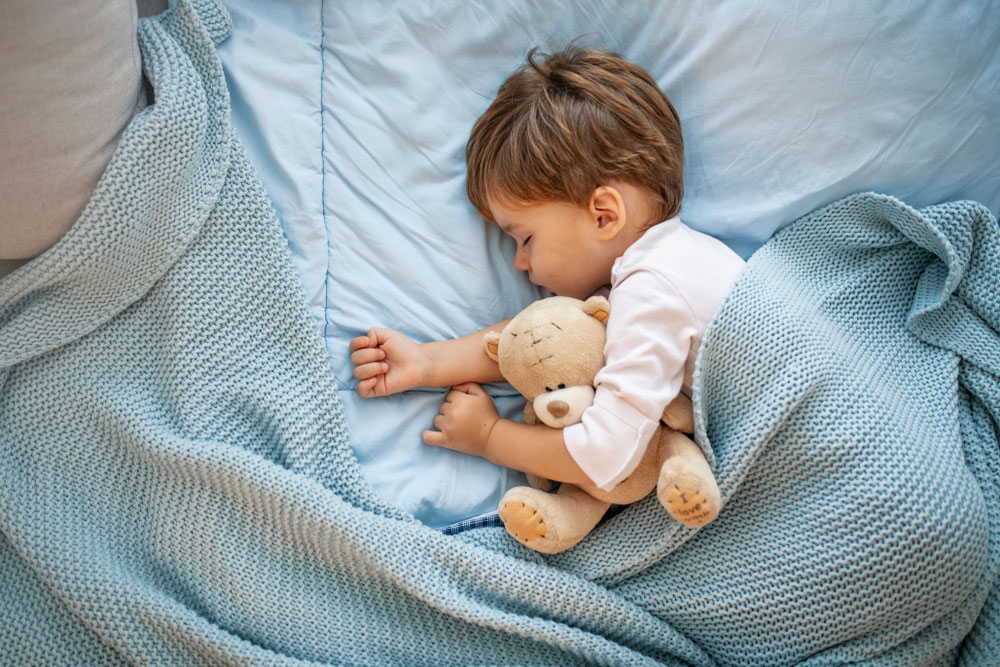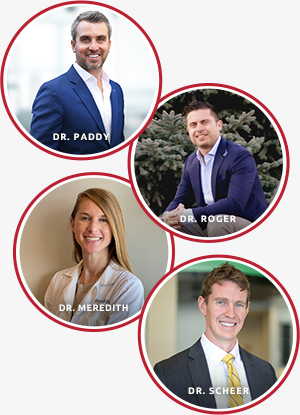
We all need sleep. And for kids, sleep is extra essential. It’s prime time for developing healthy brains and bodies, especially during those growing years. But sometimes, kids don’t get the rest they need: the occasional sleepover or too much sugar before bed can cut into sleep time once in a while. But if a child is not getting enough sleep night after night, medical issues might be to blame. One such problem is obstructive sleep apnea (OSA): when a child stops breathing for a few seconds, then starts breathing again during sleep and it’s a recurring problem.
Let’s dive into obstructive sleep apnea in detail. In this post, we’ll answer:
- What is obstructive sleep apnea in kids?
- What causes obstructive sleep apnea?
- What signs signal obstructive sleep apnea in kids?
- Are there complications to sleep apnea in children?
- How is obstructive sleep apnea treated in kids?
- Can orthodontics help kids breathe better?
What is obstructive sleep apnea in kids?
Now, you’ve likely heard of sleep apnea in adults but you might be surprised to hear that kids suffer from it, too. “Really? Can kids have sleep apnea?” you ask. The short answer is, yes, sleep apnea in kids does happen. It’s most common in kids ages 2-6 but can occur at any age.
The “obstructive” in “obstructive sleep apnea” tells us there’s a physical blockage in the upper airway, causing pauses in breathing. Obstructive sleep apnea is not to be confused with another sleep disorder — central sleep apnea. The latter isn’t as common in kids and is caused by the brain not sending the right signals to the breathing system.
Some kids are more at risk of having obstructive sleep apnea because of genetics, being overweight, or having certain medical conditions like Down syndrome or Pierre-Robin syndrome.
What causes obstructive sleep apnea?
Obstructive sleep apnea means the flow of air through the nose and mouth, down the windpipe, and into the lungs is interrupted. Muscles in your child’s head and neck relax when your child falls asleep, allowing the tissues to fold closer together. Enlarged tonsils or adenoids — which are located at the back and sides of the throat — can take up a lot of space in your little one’s airway. Put these two together and you have the makings of obstructive sleep apnea.
Enlarged tonsils or adenoids might sound alarming but actually are relatively common in young children. And regardless of whether or not your child’s tonsils or adenoids are disproportionally large, these tissues are susceptible to inflammation from allergies or sickness.
As an orthodontist, Dr. Scheer has also seen how sleep apnea is caused by misaligned jaws and facial structure. A child with a narrow mouth or a deep overbite can contribute to restricted airflow once your child goes to sleep. Conversely, sleep apnea and chronic mouth breathing can change the shape of the jaw.
Okay, got it. So relaxed muscles plus enlarged tonsils or adenoids equals a temporarily compromised airway. And sometimes orthodontic issues play a part. But how does a child with obstructive sleep apnea catch their breath and resume regular breathing again? The short pauses in breathing tell your child’s body to react, meaning their head and neck muscles activate, like when your child is awake. The airway opens, allowing your child to inhale and continue breathing normally until the muscles and tissue relax again.
What signs signal obstructive sleep apnea in kids?
Signs of sleep apnea in kids are pretty obvious. The most common? You notice your child snoring, even when they’re not congested. You can also hear when your child has momentarily stopped breathing, then takes a big, snuffling gasp a few seconds later.
Other symptoms to look for include:
- Heavy breathing
- Restless sleep with lots of tossing and turning
- Mouth breathing
- Teeth grinding or clenching
- Wetting the bed
- Sleepwalking or night terrors
- Sleepiness during the day
- Behavioral issues, including ADHD-like symptoms
- Frequent infections – chronic problems with tonsils, adenoids or ear infections
Are there complications to sleep apnea in children?
Yes. And it’s likely not surprising. Children’s sleep apnea can negatively affect your child’s quality of life. And, let’s face it, yours, too. As a parent, worrying about your child’s sleep apnea and trying to address it takes a toll.
Complications from sleep apnea sometimes also act as symptoms. In addition to the above list, a child with chronic, untreated sleep apnea might find themselves with:
- Deficient growth in their upper jaw and face
- Asymmetrical facial appearance
- Forward head posture that leads to problems with spine and body alignment
- Headaches and fatigue
- Neck and shoulder tension
- Teeth grinding
- Weight abnormalities
- Academic, behavioral, developmental and social difficulties
- Falling or staying asleep, sleepwalking, or restless legs syndrome
Sometimes sleep apnea in toddlers and children can result in your child having less oxygen in their blood than is typical. A child with chronic, untreated sleep apnea can suffer permanent damage to their heart and lungs. And some medical theories say that a breathing disorder like sleep apnea can contribute to ADHD in children.
How is obstructive sleep apnea treated in kids?
We at Kids Mile High understand how distressing obstructive sleep apnea can be, so here’s some welcome news: obstructive sleep apnea can be treated!
First step? Take your child to your family doctor or pediatrician for an examination. Before you go, make a list of symptoms you’ve noticed that point to your child’s sleep apnea. Write down any questions you or your child have. Record the sounds of your child sleeping a few nights in a row so your doctor has a record of pauses in their breathing, sharp intakes of air, snoring, or restless sleeping.
To diagnose your child, your doctor will ask about your child’s symptoms, health history, and sleep patterns. The appointment will also include a physical exam. Sometimes your doctor will suggest a sleep study as the best way to confirm your child’s sleep apnea and record their patterns.
Once you’ve seen the doctor, you can also visit an orthodontist like Dr. Scheer at Kids Mile High. As an orthodontic and dentofacial orthopedic specialist, Dr. Scheer is an expert in understanding and assessing your child’s oral and facial structures—two things that can both impact and affect obstructive sleep apnea.
Your child’s oral and facial development can contribute to obstructive sleep apnea. A narrow arch or overbite can narrow the airway. Or the opposite, your child might develop jaw and facial issues because of problematic breathing with sleep apnea.
Types of Treatment
Treatment for sleep apnea in children is unique from child to child and depends on your little one’s age, symptoms, general health, and severity of their condition. Here are the most common treatments:
Surgery: Enlarged tonsils or adenoids can be removed with surgery. And don’t worry, missing them doesn’t affect your child’s day-to-day life—except that they’ll breathe and sleep better! An ear, nose and throat specialist will evaluate your child and recommend the best course of action.
Weight loss: When weight is the main reason for your child’s sleep apnea, your doctor might suggest a nutritional plan and weight loss strategy to alleviate your child’s breathing problems. Of course, this takes a lot of time and patience but the reward of breathing and sleeping well is well worth the effort!
A CPAP machine: Some kids with sleep apnea breathe easier with continuous positive airway pressure (CPAP). They wear a special mask at bedtime that delivers a steady stream of air to keep the airway open. Understandably, some children have trouble getting used to wearing the mask. But when they finally figure out how to sleep without it falling off, the change in their sleep quality and breathing is amazing.
Inhaled steroid medication: You might be picturing weightlifters with huge muscles when you hear the word “steroids.” Rest assured, the steroids we talk about here won’t turn your child into Mighty Mouse. (Although they are our little superheroes, right?) For kids with mild to moderate obstructive sleep apnea, inhaled steroids — think an asthma puffer — can help calm inflamed tonsils that obstruct breathing.
A clean-air environment: Help your child stay away from poor-quality air that has secondhand smoke, indoor pollutants, and allergens, especially when they’re sleeping. HEPA air filters in your home and your child’s bedroom can help clean the air. Cleaner indoor air also improves nasal congestion, a common sidekick for kids who have sleep apnea.
Can orthodontics help kids breathe better?
As we mentioned earlier, an orthodontist like Dr. Scheer is trained to spot facial and oral structure issues that can contribute to or cause obstructive sleep apnea. That’s why it’s important to see an orthodontist for the first time by seven years old. At that age, your child’s jaw shape is pretty much set. (Though it will grow in scale as they grow up!) Fun fact: by six years old, about 60% of a child’s facial development is complete, and by 12 years old, 90% is complete! An expert like Dr. Scheer can pretty much predict future issues by looking at what your child’s jaw and face looks like now.
If Dr. Scheer sees potential issues, he can keep an eye on them as your child grows or address them right away with early orthodontic treatment. Kids can benefit from a palate expander or the Myobrace system, a natural and gentle way to widen the arch and help open the airway.
The Myobrace system for breathing easier
We offer Myobrace at Kids Mile High because we see results: kids happy to have aligned, functional jaws and teeth. High fives for no more mouth breathing! And better sleep!
So how does the magic of Myobrace work? Myobrace is a series of appliances that apply a light force to align teeth and jaws into a natural position. It’s designed with kids in mind: they only have to wear their appliance for 1-2 hours a day, plus at night when sleeping. Add a few myofascial exercises every day and your child is off to sleep apnea-free slumber.
Myobrace is also known to help kids avoid braces when they’re older. Or in rare cases that do require some alignment, braces don’t stay on for too long.
Tackle Sleep Apnea in Kids with Kids Mile High
Well, that’s it! What you and your wee superhero need to know about obstructive sleep apnea in kids. Dr. Scheer and the team at Kids Mile High want to see your kids healthy, happy, and thriving, so if we can help treat their sleep apnea with orthodontics, let’s go for it!
Contact us today at our Englewood, Central Park or Thornton, CO office to book a free consultation. We’re here to care for your child’s orthodontic issues in a way that’s fun and comfortable for them.



